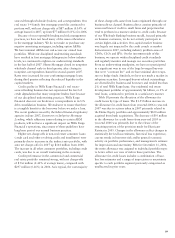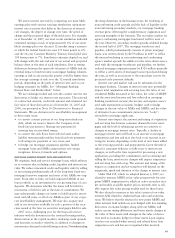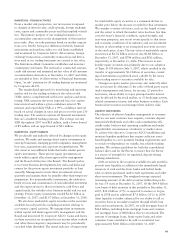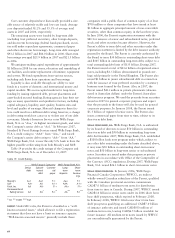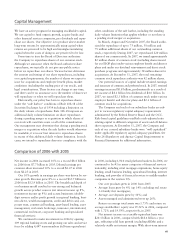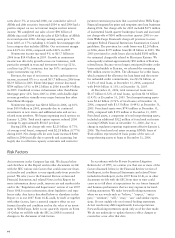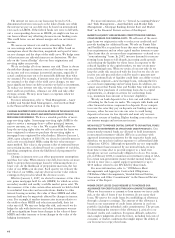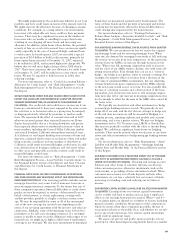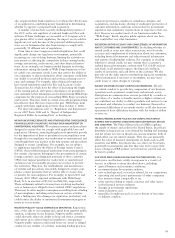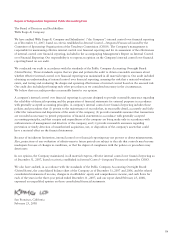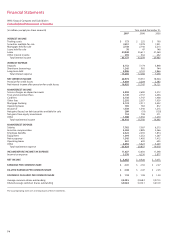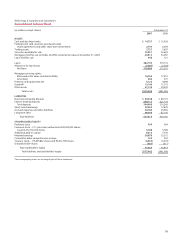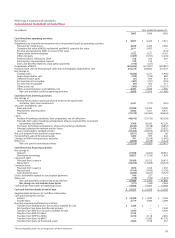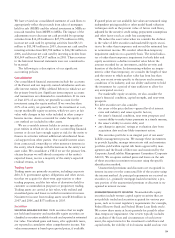Wells Fargo 2007 Annual Report Download - page 72
Download and view the complete annual report
Please find page 72 of the 2007 Wells Fargo annual report below. You can navigate through the pages in the report by either clicking on the pages listed below, or by using the keyword search tool below to find specific information within the annual report.69
We might underestimate the credit losses inherent in our loan
portfolio and have credit losses in excess of the amount reserved.
We might increase the allowance because of changing economic
conditions. For example, in a rising interest rate environment,
borrowers with adjustable-rate loans could see their payments
increase. There may be a significant increase in the number of
borrowers who are unable or unwilling to repay their loans,
resulting in our charging off more loans and increasing our
allowance. In addition, when home values decline, the potential
severity of loss on a real estate-secured loan can increase signifi-
cantly, especially in the case of loans with high combined loan-
to-value ratios. In fourth quarter 2007, we recorded a special
provision of $1.4 billion to build credit reserves, primarily for
home equity losses incurred at December 31, 2007, expected
to be realized in 2008, and incurred higher net charge-offs. We
believe that we will incur higher charge-offs in 2008 than in
2007. There is no assurance that our allowance for credit losses
at December 31, 2007, will be sufficient to cover future credit
losses. We may be required to build reserves in 2008, thus
reducing earnings.
For more information, refer to “Critical Accounting Policies –
Allowance for Credit Losses” and “Risk Management – Credit
Risk Management Process” in the Financial Review section of
this Report.
WE MAY HAVE MORE CREDIT RISK AND HIGHER CREDIT LOSSES TO THE
EXTENT OUR LOANS ARE CONCENTRATED BY LOAN TYPE, INDUSTRY
SEGMENT, BORROWER TYPE, OR LOCATION OF THE BORROWER OR
COLLATERAL. Our credit risk and credit losses can increase if our
loans are concentrated to borrowers engaged in the same or sim-
ilar activities or to borrowers who as a group may be uniquely
or disproportionately affected by economic or market condi-
tions. We experienced the effect of concentration risk in 2007
when we incurred greater than expected losses in our Home
Equity loan portfolio due to a housing slowdown and greater
than expected deterioration in residential real estate values in
many markets, including the Central Valley California market
and several Southern California metropolitan statistical areas.
As California is our largest banking state in terms of loans and
deposits, continued deterioration in real estate values and under-
lying economic conditions in those markets or elsewhere in
California could result in materially higher credit losses. In addi-
tion, deterioration in housing conditions and real estate values
in other areas and generally across the country could result in
materially higher credit losses.
For more information, refer to “Risk Management – Credit
Risk Management Process – Loan Portfolio Concentrations” in
the Financial Review section of this Report and Note 9 (Loans
and Allowance for Credit Losses) to Financial Statements in
this Report.
FINANCIAL DIFFICULTIES OR CREDIT DOWNGRADES OF MORTGAGE
AND BOND INSURERS MAY NEGATIVELY AFFECT OUR SERVICING AND
INVESTMENT PORTFOLIOS. Our servicing portfolio includes certain
mortgage loans that carry some level of insurance from one or
more mortgage insurance companies. To the extent that any of
these companies experience financial difficulties or credit down-
grades, we may be required, as servicer of the insured loan on
behalf of the investor, to obtain replacement coverage with
another provider, possibly at a higher cost than current cover-
age. We may be responsible for some or all of the incremental
cost of the new coverage for certain loans depending on the
terms of our servicing agreement with the investor and other cir-
cumstances. Similarly, some of the mortgage loans we hold for
investment or for sale carry mortgage insurance. If a mortgage
insurer is unable to meet its credit obligations with respect to an
insured loan, we might incur higher credit losses if replacement
coverage is not obtained. We also have investments in municipal
bonds that are guaranteed against loss by bond insurers. The
value of these bonds and the payment of principal and interest
on them may be negatively affected by financial difficulties or
credit downgrades experienced by the bond insurers.
For more information, refer to “Earnings Performance –
Balance Sheet Analysis – Securities Available for Sale” and “Risk
Management – Credit Risk Management Process” in the
Financial Review section of this Report.
OUR MORTGAGE BANKING REVENUE CAN BE VOLATILE FROM QUARTER
TO QUARTER. We earn revenue from fees we receive for originat-
ing mortgage loans and for servicing mortgage loans. When
rates rise, the demand for mortgage loans tends to fall, reducing
the revenue we receive from loan originations. At the same time,
revenue from our MSRs can increase through increases in fair
value. When rates fall, mortgage originations tend to increase
and the value of our MSRs tends to decline, also with some off-
setting revenue effect. Even though they can act as a “natural
hedge,” the hedge is not perfect, either in amount or timing. For
example, the negative effect on revenue from a decrease in the
fair value of residential MSRs is immediate, but any offsetting
revenue benefit from more originations and the MSRs relating
to the new loans would accrue over time. It is also possible that,
because of a slowing economy and a deterioration of the hous-
ing market, even if interest rates were to fall, mortgage origina-
tions may also fall or any increase in mortgage originations may
not be enough to offset the decrease in the MSR value caused by
the lower rates.
We typically use derivatives and other instruments to hedge
our mortgage banking interest rate risk. We generally do not
hedge all of our risk, and the fact that we attempt to hedge any
of the risk does not mean we will be successful. Hedging is a
complex process, requiring sophisticated models and constant
monitoring, and is not a perfect science. We may use hedging
instruments tied to U.S. Treasury rates, LIBOR or Eurodollars
that may not perfectly correlate with the value or income being
hedged. We could incur significant losses from our hedging
activities. There may be periods where we elect not to use deriv-
atives and other instruments to hedge mortgage banking interest
rate risk.
For more information, refer to “Risk Management – Asset/
Liability and Market Risk Management – Mortgage Banking
Interest Rate and Market Risk” in the Financial Review section
of this Report.
OUR BANK CUSTOMERS COULD TAKE THEIR MONEY OUT OF THE BANK
AND PUT IT IN ALTERNATIVE INVESTMENTS, CAUSING US TO LOSE A
LOWER COST SOURCE OF FUNDING. Checking and savings account
balances and other forms of customer deposits can decrease
when customers perceive alternative investments, such as the
stock market, as providing a better risk/return tradeoff. When
customers move money out of bank deposits and into other
investments, we can lose a relatively low cost source of funds,
increasing our funding costs and reducing our net interest
income.
OUR VENTURE CAPITAL BUSINESS CAN ALSO BE VOLATILE FROM QUARTER
TO QUARTER. Earnings from our venture capital investments
can be volatile and hard to predict and can have a significant
effect on our earnings from period to period. When— and if—
we recognize gains can depend on a number of factors, including
general economic conditions, the prospects of the companies in
which we invest, when these companies go public, the size of
our position relative to the public float, and whether we are sub-
ject to any resale restrictions. Our venture capital investments
could result in significant losses.
We assess our private and public equity portfolio at least
quarterly for other-than-temporary impairment based on a number


